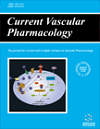- Home
- A-Z Publications
- Current Vascular Pharmacology
- Previous Issues
- Volume 5, Issue 1, 2007
Current Vascular Pharmacology - Volume 5, Issue 1, 2007
Volume 5, Issue 1, 2007
-
-
Pharmacologic Modulators of Soluble Guanylate Cyclase/Cyclic Guanosine Monophosphate in the Vascular System - From Bench Top to Bedside
More LessAuthors: Elias B. Jackson, Somnath Mukhopadhyay and David A. TulisGuanosine-dependent cyclic nucleotide second messenger signaling has been implicated as a pivotal mediator of vascular function under both homeostatic eutrophic conditions as well as in the inimical environs of injury and/or disease. This biological system is highly regulated through reciprocal, complimentary, and often redundant upstream and downstream molecular and cellular elements and feedback controls. Key Read More
-
-
-
Use of BNP and CRP as Biomarkers in Assessing Cardiovascular Disease:Diagnosis Versus Risk
More LessAuthors: Virginia M. Miller, Margaret M. Redfield and Joseph P. McConnellBiomarkers are used in medicine to facilitate diagnosis, assess risk, direct therapy and determine efficacy of treatment. Sensitivity and specificity are essential in order for a biomarker to be useful. Brain natriuretic peptide (BNP) and C-reactive protein (CRP) are considered biomarkers of cardiovascular disease. However, they differ in function, sensitivity and specificity. BNP is released from the myocardium in response to Read More
-
-
-
Do Adult Stem Cells Ameliorate the Damaged Myocardium? Human Cord Blood as a Potential Source of Stem Cells
More LessAuthors: Elise M. K. Furfaro and Mohamed A. GaballaThe heart does not mend itself after infarction. However, stem cells may revolutionize heart disease treatment. A vast and growing body of evidence indicates that cell-based strategies have promising therapeutic potential. Recent clinical and pre-clinical studies demonstrate varying degrees of improvement in cardiac function using different adult stem cell types such as bone marrow (BM)-derived progenitor cells and Read More
-
-
-
Endothelin-1-Induced Signaling Pathways in Vascular Smooth Muscle Cells
More LessAuthors: Ali Bouallegue, Grace Bou Daou and Ashok K. SrivastavaEndothelin-1 (ET-1), a vasoactive peptide, is believed to contribute to the pathogenesis of vascular abnormalities such as hypertension, atherosclerosis, hypertrophy and restenosis. ET-1 elicits its biological effects through the activation of two receptor subtypes, ET-A and ET-B that belong to a large family of transmembrane guanine nucleotide-binding protein-coupled receptors (GPCRs). ET-1 receptor activation resu Read More
-
-
-
Optical Techniques in the Assessment of Peripheral Arterial Disease
More LessA variety of optical techniques have been developed over the years for experimental use in vascular disease, mainly for the assessment of lower limb peripheral arterial disease (PAD). Optical techniques have several advantages over more traditional experimental approaches. Photoplethysmograph (PPG) was one of the earliest methods used for this purpose; PPG satisfies many of the conditions for a non-invasi Read More
-
-
-
Vascular Disease: A New Progenitor Biology
More LessAuthors: Pat Metharom and Noel M. CapliceVascular disease is primarily the result of atherosclerosis which affects all layers of the adult vessel wall. Our understanding of atherosclerosis has evolved over the past three decades; from initial hypotheses based on lipid deposition and fibrocellular proliferation within the intima of the vessel wall to a more complex interplay between conventional risk factors, inflammation and the immune system implicating pan-vascular biol Read More
-
-
-
Equilibrative Nucleoside (ENTs) and Cationic Amino Acid (CATs) Transporters: Implications in Foetal Endothelial Dysfunction in Human Pregnancy Diseases
More LessAuthors: Paola Casanello, Carlos Escudero and Luis SobreviaGestational diabetes (GD, characterized by abnormal D-glucose metabolism), intrauterine growth restriction (IUGR, a disease associated with reduced oxygen delivery (hypoxia) to the foetus), and preeclampsia (PE, a pregnancy complication characterized by high blood pressure, proteinuria and increased vascular resistance), induce foetal endothelial dysfunction with implications in adult life and increase the risk o Read More
-
-
-
The Significance of Endothelium-Derived Hyperpolarizing Factor in the Human Circulation
More LessAuthors: Qin Yang, Anthony P. C. Yim and Guo-Wei HeAlthough nitric oxide (NO) is recognized as the primary vasodilator derived from vascular endothelium in regulating the vascular tone, another factor, i.e. the endothelium-derived hyperpolarizing factor (EDHF), has recently gained much attention and has been demonstrated to participate in vasodilatation in various blood vessels from different species, despite its unidentified nature. Most of the studies were conducted in anim Read More
-
Volumes & issues
-
Volume 23 (2025)
-
Volume 22 (2024)
-
Volume 21 (2023)
-
Volume 20 (2022)
-
Volume 19 (2021)
-
Volume 18 (2020)
-
Volume 17 (2019)
-
Volume 16 (2018)
-
Volume 15 (2017)
-
Volume 14 (2016)
-
Volume 13 (2015)
-
Volume 12 (2014)
-
Volume 11 (2013)
-
Volume 10 (2012)
-
Volume 9 (2011)
-
Volume 8 (2010)
-
Volume 7 (2009)
-
Volume 6 (2008)
-
Volume 5 (2007)
-
Volume 4 (2006)
-
Volume 3 (2005)
-
Volume 2 (2004)
-
Volume 1 (2003)
Most Read This Month
Article
content/journals/cvp
Journal
10
5
false
en


